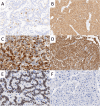Renal neuroendocrine tumors: clinical and molecular pathology with an emphasis on frequent association with ectopic Cushing syndrome
- PMID: 37405461
- PMCID: PMC10611615
- DOI: 10.1007/s00428-023-03596-5
Renal neuroendocrine tumors: clinical and molecular pathology with an emphasis on frequent association with ectopic Cushing syndrome
Abstract
Renal neuroendocrine tumors (RenNETs) are rare malignancies with largely unknown biology, hormone expression, and genetic abnormalities. This study aims to improve our understanding of the RenNETs with emphasis of functional, hormonal, and genetic features. Surgically resected RenNETs (N = 13) were retrieved, and immunohistochemistry and next-generation sequencing (NGS) were performed in all cases. In addition, all published RenNETs were systematically reviewed. Our cohort (4 men and 9 women, mean age 42, mean tumor size 7.6 cm) included 2 patients with Cushing syndrome (CS). WHO grade (23% G1, 54% G2, and 23% G3) and tumor progression did not correlate. CS-associated RenNETs (CS-RenNETs) showed a solid and eosinophilic histology and stained for ACTH, while the remaining non-functioning tumors had a trabecular pattern and expressed variably hormones somatostatin (91%), pancreatic polypeptide (63%), glucagon (54%), and serotonin (18%). The transcription factors ISL1 and SATB2 were expressed in all non-functioning, but not in CS-RenNETs. NGS revealed no pathogenic alterations or gene fusions. In the literature review (N = 194), 15 (8%) of the patients had hormonal syndromes, in which CS being the most frequent (7/15). Large tumor size and presence of metastasis were associated with shorter patients' survival (p < 0.01). RenNETs present as large tumors with metastases. CS-RenNETs differ through ACTH production and solid-eosinophilic histology from the non-functioning trabecular RenNETs that produce pancreas-related hormones and express ISL1 and SATB2. MEN1 or DAXX/ARTX abnormalities and fusion genes are not detected in RenNETs, indicating a distinct yet unknown molecular pathogenesis.
Keywords: Hormone; ISL1; Kidney; Neuroendocrine neoplasms; SATB2.
© 2023. The Author(s).
Conflict of interest statement
The authors declare no competing interests.
Figures



Similar articles
-
Gene fusions are frequent in ACTH-secreting neuroendocrine neoplasms of the pancreas, but not in their non-pancreatic counterparts.Virchows Arch. 2023 Mar;482(3):507-516. doi: 10.1007/s00428-022-03484-4. Epub 2023 Jan 24. Virchows Arch. 2023. PMID: 36690805 Free PMC article.
-
ARX, PDX1, ISL1, and CDX2 Expression Distinguishes 5 Subgroups of Pancreatic Neuroendocrine Tumors With Correlations to Histology, Hormone Expression, and Outcome.Mod Pathol. 2024 Nov;37(11):100595. doi: 10.1016/j.modpat.2024.100595. Epub 2024 Aug 13. Mod Pathol. 2024. PMID: 39147030
-
Subtyping of pancreatic neuroendocrine tumors by transcription factors, hormones, histology, and patient outcome.Pathologie (Heidelb). 2024 Nov;45(Suppl 1):20-25. doi: 10.1007/s00292-024-01367-w. Epub 2024 Oct 8. Pathologie (Heidelb). 2024. PMID: 39377913 English.
-
ACTH-secreting pancreatic neoplasms associated with Cushing syndrome: clinicopathologic study of 11 cases and review of the literature.Am J Surg Pathol. 2015 Mar;39(3):374-82. doi: 10.1097/PAS.0000000000000340. Am J Surg Pathol. 2015. PMID: 25353285 Review.
-
ACTH-Secreting Neuroendocrine Carcinoma of the Cecum: Case Report and Review of the Literature.Clin Colorectal Cancer. 2019 Mar;18(1):e163-e170. doi: 10.1016/j.clcc.2018.07.013. Epub 2018 Aug 11. Clin Colorectal Cancer. 2019. PMID: 30314823 Review.
Cited by
-
Rapid Evolution of Metastases in Patients with Treated G3 Neuroendocrine Tumors Associated with NEC-Like Transformation and TP53 Mutation.Endocr Pathol. 2024 Dec;35(4):313-324. doi: 10.1007/s12022-024-09827-y. Epub 2024 Oct 9. Endocr Pathol. 2024. PMID: 39382626 Free PMC article.
-
Cushing's Syndrome due to a Renal Neuroendocrine Tumor: A Case Report.Case Rep Oncol. 2025 Apr 14;18(1):593-601. doi: 10.1159/000545734. eCollection 2025 Jan-Dec. Case Rep Oncol. 2025. PMID: 40416330 Free PMC article.
-
Primary Renal Neuroendocrine Tumor Presenting as Ectopic ACTH Syndrome.JCEM Case Rep. 2025 Apr 23;3(6):luaf092. doi: 10.1210/jcemcr/luaf092. eCollection 2025 Jun. JCEM Case Rep. 2025. PMID: 40270995 Free PMC article.
-
Pathogenesis, diagnosis and treatment of primary renal well-differentiated neuroendocrine tumors: a review of the literature.Front Oncol. 2024 Oct 4;14:1298559. doi: 10.3389/fonc.2024.1298559. eCollection 2024. Front Oncol. 2024. PMID: 39429475 Free PMC article.
References
-
- Agaimy A, Erlenbach-Wunsch K, Konukiewitz B, Schmitt AM, Rieker RJ, Vieth M, Kiesewetter F, Hartmann A, Zamboni G, Perren A, Klöppel G. ISL1 expression is not restricted to pancreatic well-differentiated neuroendocrine neoplasms, but is also commonly found in well and poorly differentiated neuroendocrine neoplasms of extrapancreatic origin. Mod Pathol. 2013;26:995–1003. doi: 10.1038/modpathol.2013.40. - DOI - PubMed
-
- Agaimy A, Kasajima A, Stoehr R, Haller F, Schubart C, Togel L, Pfarr N, von Werder A, Pavel ME, Sessa F, Uccella S, La Rosa S, Kloppel G. Gene fusions are frequent in ACTH-secreting neuroendocrine neoplasms of the pancreas, but not in their non-pancreatic counterparts. Virchows Arch. 2023;482:507–516. doi: 10.1007/s00428-022-03484-4. - DOI - PMC - PubMed
-
- Asa SL, Arkun K, Tischler AS, Qamar A, Deng FM, Perez-Ordonez B, Weinreb I, Bishop JA, Wenig BM, Mete O (2021) Middle ear “adenoma”: a neuroendocrine tumor with predominant L cell differentiation. Endocr Pathol. 10.1007/s12022-021-09684-z - PubMed
MeSH terms
Substances
Grants and funding
LinkOut - more resources
Full Text Sources
Medical

